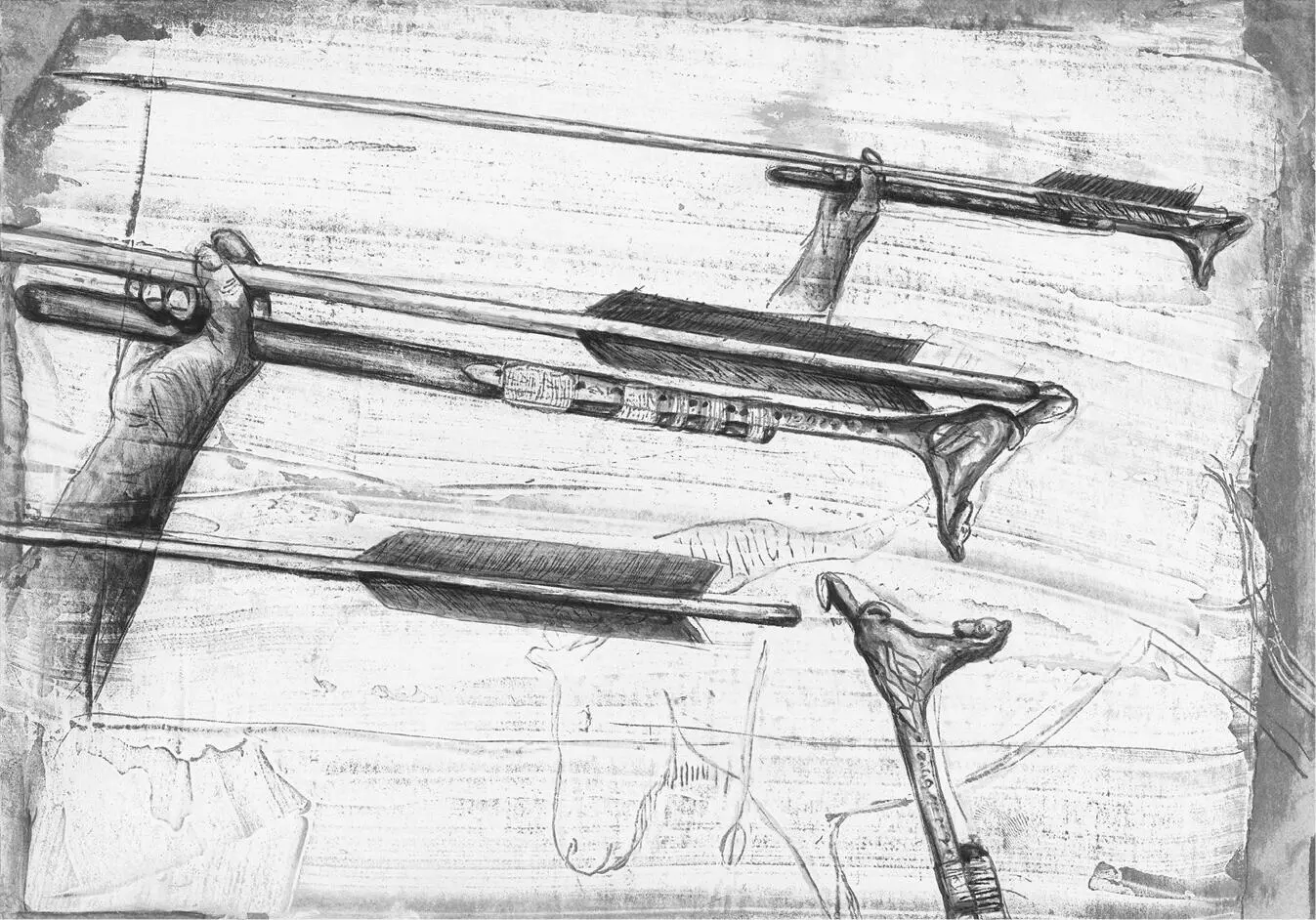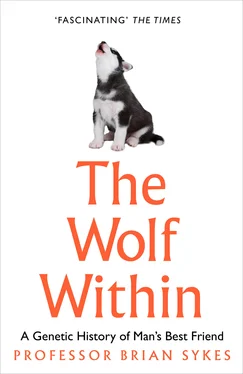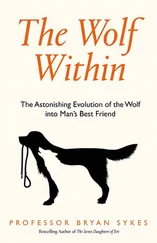There are no human remains in Chauvet cave and, other than the drawings, very little sign of human presence. Nobody lived in Chauvet. What then was the purpose of these drawings, made with such effort and such skill? Clearly they were not purely decorative in the way we might hang a favourite painting on the wall above the fireplace. Although we will never know for certain, to many eyes these beautiful drawings are a tangible expression of a world of imagination and spirituality that marked the rise of truly modern humans.
An aspiration to go beyond what is absolutely necessary for function is also apparent in the stone tools our ancestors left behind. Whereas Neanderthals made perfectly functional tools like hand axes and thrusting spear points, they appear clumsy in comparison to the beautifully fashioned arrow points of the Upper Palaeolithic. The flint itself was traded over long distances and it supplied the raw material for individual craftsmen to demonstrate their skill. Fashioning a flint arrowhead or spear point was an opportunity not just to replace equipment lost in the hunt but also to demonstrate a high level of dexterity.
Quite suddenly, archaeological sites of the period were flooded with personal adornments. Excavations in south-west France reveal the appearance of bracelets, pendants and beads exquisitely fashioned from bone, antler and ivory. Seashells from the Mediterranean are found in sites hundreds of kilometres from the coast. Splinters of stone called burins were used to drill out holes in animal skins so that they could be sewn together with sinews for clothing. The effort involved was substantial.
Further afield at Sungir, 200 kilometres to the east of Moscow, archaeologists have excavated five human burials dated to 32,000 years BP, one of which contains the remains of a boy almost covered in strands of beads. There were nearly 5,000 beads in all, each one taking an estimated forty-five minutes to an hour to produce, a total of at least 4,000 hours in the making. On his head he wore a cap decorated with more beads as well as the canine teeth of at least sixty Arctic foxes. This was evidently the resting place of someone from an important family, a clear sign of social stratification emerging very soon after our ancestors arrived in Europe.
Our impression of our Stone Age ancestors is one of brutish simpletons clinging on in the face of appalling odds, surrounded by vicious and hungry predators looking for an easy meal. Certainly, their world was full of danger and life was hard. Nevertheless not every minute was taken up by the struggle to survive, and the evidence from Sungir shows that in some circumstances there was enough of a surplus for what we might imagine to be luxury, at least for a few. This was the world into which the wolf-dog was welcomed.
Far from being frightened prey cowering inside dank refuges, by the beginning of the Upper Palaeolithic our ancestors were well on the way to becoming top predators themselves. One by one the carnivores that once struck fear into the Neanderthals were driven to extinction. That perennial whipping boy of evolution, climate change, may have been the underlying influence behind the diminishing herds of mammoth and bison. But the climate had been changing for a very long time. Only when our ancestors arrived on the scene around 40,000 to 50,000 years ago did numbers of megafauna plummet. First the mammoth and the woolly rhinoceros vanished from the steppes, followed by the giant elk Megaloceros , then the bison and the wild horse. These were the herbivores that nourished the guild of carnivores and whose demise presaged their own extinction. The cave lion, leopard, hyena and sabre-toothed cat all vanished. The fearsome cave bear Ursus spelaeus who fought our ancestors for living space soon followed. Only the brown bear, Ursus arctos , managed to survive in the face of human competition by more or less abandoning meat altogether and restricting its diet to plants, berries and the occasional small mammal. At the end of the Palaeolithic all the large mammals, herbivores and carnivores alike, whose images jostled for space on the lime-smoothed walls of Chauvet, were gone.
A parallel wave of extinctions swept North America once humans arrived in numbers. As a species, we have never been good at taking responsibility for the damage we inflict, and the role humans played in the extinction of the North American megafauna is hotly debated. There is no doubt in my mind that both in Europe and in America it was our own human ancestors that pushed species after species over the edge into oblivion. In Europe none survived the hunting onslaught of our ancestors, but in North America, when the mammoth and the woolly rhinoceros went under, the elk and the buffalo survived.
Although technical invention in hunting equipment no doubt helped our ancestors to become the top predators, there was more to it than that. Certainly, the atlatl or spear-thrower was a deadly innovation which allowed our ancestors to kill at a distance and avoid injury, though alone it was hardly enough to account for the decimation of the megafauna. This piece of equipment was certainly one ingredient in our progress towards dominance of the Upper Palaeolithic world, but it seems unlikely that we achieved this distinction just because we could throw spears further and with more force than before. It was the revolution in our minds that took place all those years ago, as witnessed by the lavishly decorated burials of the children of Sungir and the gleaming frescoes of Chauvet, that really made the difference.

Artwork of how a spear-thrower (or atlatl) is used to throw a feathered dart. At top and centre, the dart is loaded. At bottom, it is being thrown. The angular momentum imparted means dart speeds of 150 kilometres per hour can be achieved, making this a lethal weapon in the hands of a skilled hunter. In the background is a cave painting of an animal wounded by an atlatl dart. The earliest such weapons were found at Schoningen, Germany, in the 1990s, dating to over 300,000 years ago. (KENNIS AND KENNIS/MSF/SCIENCE PHOTO LIBRARY)
In a narrow gallery towards the back of the Chauvet cave complex is a tantalising glimpse of another secret of this revolution. Impressed in the soft sediment that forms the floor of the cave are the clear impressions of a child’s footprints. He or she, let us say he, was about eight years old. What he was doing that far back in the pitch-black cavern we can only imagine. From the measurements of his gait he was walking quite normally, not running nor hesitating on his way to the back of the cave. Human footprints of this age are very rare indeed, but it is not the track of the boy that makes this so unusual and important for our story. Alongside the child’s is another, quite different, set of prints. Perfectly preserved in the limey sediment that covers the cave floor, hidden from view and undisturbed for 30,000 years, are the tracks of a fully-grown wolf.
We cannot be sure that the boy and the wolf were walking side by side when they made the tracks or whether the prints were left thousands of years apart. The passage is very narrow at this point and yet the tracks never cross each other, making it more than likely that they were made at the same time. Was the wolf hunting the boy? Or were they exploring the cave together, companions in a great adventure? The footprints hint at a very close relationship, friendship even, between the boy and the wolf.
Or was the animal that trotted comfortably at the boy’s side no longer a wolf, but already on its way to becoming a dog?
*This is the ‘Cave of Forgotten Dreams’ of the chapter title. I have taken the name from Werner Herzog’s excellent 2010 documentary film about Chauvet cave.
Читать дальше













